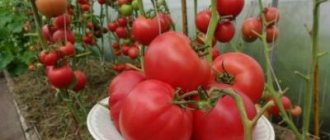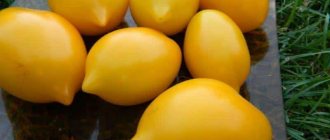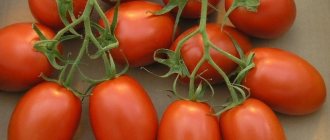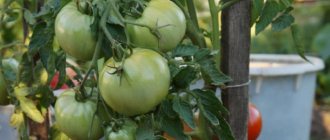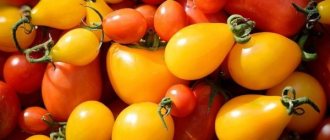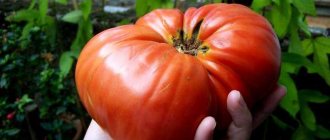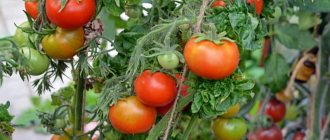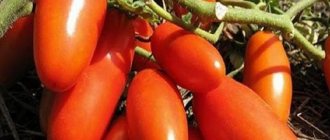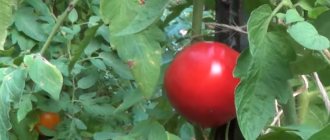For more than 100 years, debates have not subsided about which group of agricultural crops the tomato belongs to: a berry or a vegetable. According to the method of agricultural use, it is a vegetable crop that is grown for its non-dessert fruits that are used as food. Botanists think differently. The tomato fruit is a two-locular or multi-locular berry.
Where did the tomato come from?
Tomatoes originally grew in South America, in the region of Peru. There you can still find tomatoes living in the wild. Tomatoes appeared in Europe in the 15th century, thanks to Christopher Columbus. However, for 200 long years, Europeans did not dare to eat them, fearing their poisonous properties. Tomatoes were grown as houseplants or used to decorate gazebos, like grapes.
The Spaniards were the first to try tomatoes as food, as records of the earliest culinary recipes using tomatoes were discovered.
Also, there is a version that the tomatoes came from Mexico. Already in the 16th century, Mexicans cultivated this either vegetable or fruit.
Is a tomato a vegetable or a fruit?
Outwardly, there are quite convincing features indicating that the tomato is more a fruit than a vegetable.
Taking this into account, all people will unanimously exclaim: “That’s right, a tomato is not a vegetable, but a fruit!” If it’s not one thing or the other, you might think. Even many scientists support this point of view, since from Latin “fructus” means fruit. And outwardly, there are quite convincing features indicating that the tomato is more a fruit than a vegetable. But why isn't this fruit sweet? And why does it have so many seeds if other fruits, such as apples and peach, do not have this?
Appearance in Russia
Russians have been eating tomatoes since the late 18th century. A little earlier, it was brought into the country from Romania and Turkey, but people were in no hurry to eat it. When in the southern regions of Astrakhan, Crimea and Georgia it was already used as a vegetable and used for food, in the northern regions it was used to decorate houses, using it as ornamental plants.
Catherine the Second tried the tomato in 1780: an unprecedented fruit was delivered from Rome. By the 19th century, tomatoes had spread throughout most of Russia.
What is a tomato from different points of view?
“Which group does the tomato belong to?” — this question has been pondered in different countries for more than a century. Basic definitions of this culture:
- In dictionary.
The common tomato is a vegetable crop that grows on all continents. It is cultivated everywhere in Russia (in the Far North in greenhouses and greenhouses). The yield in protected soil is 5-15 kg per 1 m2, in open beds it is 150-250 centners per hectare.
- From a biological point of view, tomato (lat. Solanum lycopersicum).
It is a herbaceous plant (annual or perennial) belonging to the nightshade family (Solanaceae). Stem length from 30 cm to 5 m. Tap root system, dissected leaves. Inflorescences are flower or fruit racemes (simple, intermediate or complex). Flowers are bisexual, self-pollinating.
The fruit is a juicy two-locular or multi-locular berry with a smooth or ribbed surface of various shapes.
- From the point of view of the average person.
This is a vegetable, since it grows in the garden, and is used for preparing first and second courses and salads. The fruit is not sweet, so it is not a dessert.
Where does the name come from?
They called these juicy fruits whatever they called them. The Aztecs called them "matl". When they appeared in Europe, when no one thought of eating them, the name already sounded like “tomatl”. Both names mean “berry”.
After tasting them, the Italians began to call these fruits “pommo d'oro”, which means “golden apple”. The French added their own charm to the name by dubbing them the “pommo d'amoure” love apple.
The French and Italian names took root in Russia, which is where the word “tomato” was born. Some translated from French, and in Russian they called the tomato “love apple.” Other names for tomatoes in Russia were “red eggplant,” “dog,” “mad berry,” or “wolf berry.”
Basic rules for selecting and storing tomatoes
When choosing tomatoes, you need to pay attention to some details. After all, a low-quality product will not only have a bad taste, but can also cause damage to health.
When purchasing, you need to pay attention to the following:
- Appearance. For people who are prone to allergic reactions, it is better not to take a red vegetable. If there is a greenish spot around the stalk, then the fruit has ripened after it was picked. This vegetable partially loses its beneficial properties.
- View inside. It would be nice to carefully examine such a vegetable when cut. It should be quite juicy, not flaccid and without white veins, and the chambers should be completely filled.
- Ribbing. Typically, tomatoes with a ribbed surface contain the largest number of chambers. But the more chambers, the worse the taste; in addition, such specimens quickly crack.
- Touch the tomatoes. If the vegetable is too soft, it means it is overripe, and if it is too hard, then most likely it is not ripe. A thick peel indicates the use of nitrates during cultivation.
- Smell. A good quality tomato has a pleasant aroma. Unripe tomatoes do not emit aroma at all, or it is weakly expressed.
Important! Long-term storage in the refrigerator negatively affects the taste of tomatoes, so it is recommended to store them at room temperature
, for example, by placing them on the table.
It is necessary to ensure that this product is not exposed to direct sunlight. When storing tomatoes, you should adhere to the following rules:
- well-ripened specimens are stored for no more than 3 days;
- in the refrigerator in the vegetable section the shelf life is slightly longer - 7 days;
- When storing large quantities of tomatoes, wooden boxes or cardboard boxes are usually used, in which sawdust or straw is placed. Vegetables are placed in such a prepared container with the stalk facing up. In this case, each layer is covered on top with sawdust (straw). Store them in a well-ventilated area with an air temperature of 8–12°C;
- Small tomatoes are more suitable for storage than large ones.
For better storage, you need to buy tomatoes with a stalk.
Tomatoes in court
To find out whether a tomato is a fruit or a vegetable, one even had to go to court.
Thus, at the end of the 19th century, a US court considered the case of a tomato, determining at the highest level whether it was a fruit or a vegetable. I had to figure out how to get a tomato through customs. The fact is that for transporting vegetables across the border, it was necessary to pay a customs duty, while fruits and berries were not subject to duty.
After careful consideration of the case, the US Supreme Court issued a ruling that defined the tomato as a vegetable. No matter how much botanists insisted on the opposite.
But in Europe, since 2001, the tomato has been rehabilitated, recognizing it as a fruit.
Where and how does a tomato grow?
Tomatoes are a heat-loving vegetable crop. In Europe, tomatoes are grown as annual plants, and in their historical homeland - in Central and South America, they grow and bear fruit for several years. On such plantations, the height of the stems reaches several meters.
Even the most temperature-resistant breeding varieties are demanding of heat and moisture:
- At temperatures below 10 degrees, tomatoes' growth slows down and sometimes stops altogether, leaves and stems darken, susceptibility to disease increases, and wilting occurs. Light frosts lead to the appearance of transparent spots on the fruits, which lead to their rotting. The optimal temperature regime at which fruits grow and develop well is in the range of +20-25 degrees Celsius.
- Tomatoes are light-loving annual plants; they do not tolerate darkening; a lack of sunlight leads to overgrowth of the stem; etiolation (growing in the dark) is strictly contraindicated for them.
- Tomatoes are very demanding on the composition of the soil and its moisture content, especially during the fruiting period. Lack of water causes slower growth, shedding of flowers, reduction in the size of tomatoes, and the appearance of blossom end rot. Excessive watering leads to cracking of the fruit.
In the southern regions of Russia, tomatoes are planted in open ground; more than 25% of all areas allocated for vegetable plantations are occupied by it. Dwarf varieties of early ripening determinant are suitable for growing outdoors.
In the middle zone, greenhouse and hothouse growing methods are more often used. Caring for vegetables in a greenhouse involves maintaining a constant favorable temperature and regular watering.
Tomatoes are harvested as they ripen; mass harvesting begins in early August and continues until the first frost.
Arguments in favor of vegetables
If we evaluate the tomato from a culinary point of view, then it is a vegetable. Even on store shelves it lies next to carrots, potatoes and cabbage. The method of growing a tomato is also similar to a vegetable. It is planted as seedlings, an annual crop, loosened and hilled, and at the end harvested.
The definition of vegetable tells you that it is the edible part of a plant. As a rule, vegetables are the harvest of cultivated garden plants. They cannot be found wild somewhere in fields and forests. Edible plant food, excluding grains, nuts and fruits, is also the definition of a vegetable. This all sounds like a description of a tomato.
Description of the fruit - an edible fruit that develops from the ovary of a flower. This flower must be pollinated. It is known that a tomato starts from a flower, and then the fruit ripens. So the tomato is a fruit. Berry is one version of the fruit. More precisely, a fruit that has not one, but many seeds inside, a thin shell and pulp. Does it look like a tomato? It turns out that he is a berry?
Characteristics of tomato varieties
The most delicious varieties of tomatoes
- Caring for tomatoes during flowering - proper planting, feeding and fertilizing tomatoes (105 photos)
Ordinary people are accustomed to calling and considering a tomato a vegetable. No matter what evidence is given, no matter how this or that position is argued, to the question “is a tomato a berry or a vegetable?” — most of the population will answer: “Vegetable!”
In the life of the average person, a tomato will remain a vegetable.
Classification of fruits from a scientific point of view
The final stage of flower development is called the fruit. It is formed under the influence of double fertilization. This is a generative organ that serves for the formation, development and distribution of seeds.
In different countries and at different times, tomato fruits were classified as vegetables, fruits or berries.
The main differences between these fruits.
- The berry is a multi-seeded fruit, the pulp is juicy, covered with a thin leathery epicarp (outer covering).
- Fruit is a juicy edible fruit of a bush or tree. This is not a scientific, but a common name. Usually refers to large fruits.
- Vegetable is a culinary and agricultural term that is quite vague. According to the definition of TSHA professor V.I. Edelshtein, these are “herbaceous plants cultivated for their succulent parts, used for human food.” This group includes plants whose roots, leaves, stems or fruits are eaten.
Tomato varieties
Regardless of whether it is a tomato, a vegetable or something else, it is loved by many. The variety of varieties allows you to please any gourmet.
Tomatoes are usually red in color and really resemble an apple in shape. But there are yellow, orange and even black varieties of tomatoes. There are fruits that are completely green, even if they are ripe. There are purple and striped tomatoes.
What kind of soil do tomatoes like - the optimal composition of the soil for planting tomatoes and its characteristics + 100 photos
Is it necessary to plant cherry tomatoes - forming and growing mini tomatoes in open ground, in greenhouses and greenhouses (120 photos and videos)
Tomato varieties for open ground: the best productive varieties. 125 photo and video recommendations from experts
They can also be different in shape: from fleshy huge “Ox Heart” tomatoes to small Cherry tomatoes.
Description and characteristics of the fruit
The tomato came to us from the South American continent during its colonization by the Spaniards in the mid-16th century. At first, tomatoes were grown by Europeans as an exotic plant, and the edibility of its fruits was in doubt. In the 18th century, it came to the Russian Empire, where it was first considered an exotic ornamental plant, until the Russian botanist and writer A. T. Bolotov obtained tomatoes of full ripeness by applying to them the methods of growing seedlings and ripening.
Did you know? Bolotov Andrei Timofeevich lived a long life (1738–1833) and made a huge contribution to the development of Russian agronomy. He introduced potatoes and tomatoes into agriculture and developed agricultural techniques for growing them. He promoted eating foods that were grown locally rather than imported from other countries or regions.
Tomato fruits are multi-locular berries of various rounded shapes (from flat to elongated cylinder). The weight of different varieties can range from 20 g to more than 1 kg. Depending on the size of the fruit, tomatoes are divided into small-fruited (up to 50 g), medium-fruited (up to 100 g) and large-fruited (from 100 g). Tomatoes have from 2 to 20 chambers filled with seeds and juice inside, and according to their number, varieties are divided into small-chambered (2-3 chambers), medium-chambered (4-8), multi-chambered (more than 9). The thicker the walls of the chambers, the fleshier the fruits. The color of human-grown tomatoes is predominantly red, but there are varieties with yellow, orange, black, green, purple and whitish colors.
The benefits of tomato
It is difficult to describe the importance and usefulness of these fruits. Potassium, magnesium, phosphorus, calcium - you can list for a long time the mass of useful substances contained in tomatoes.
Tomato contains the beneficial substance lycopene, which reduces the risk of developing atherosclerosis and cataracts. Tomatoes help improve digestion, reduce blood pressure, and improve the flow of bile in case of cholelithiasis. It has been proven that these fruits contain phytoncides.
Lycopene is a strong antioxidant that is beneficial not only for health, but also for beauty. That is why cosmetic products are developed based on tomatoes.
What determines the color of a tomato?
Delicious, juicy fruits can be of different colors - red, green, yellow. The color of the peel and pulp depends on the variety of garden plant. Tomatoes of black and dark purple shades are less common.
Color variety of varieties
The color depends on the concentration of two natural dyes in the fibers - carotene and lycopene.
- Carotene is a precursor of vitamin A, a yellow-orange pigment. The more of it there is in the pulp, the more intensely red the tomato will be. The substance is useful for humans, as it has immunostimulating and adaptogenic effects.
- Lycopene is a carotenoid pigment. The substance is not toxic, but its abuse can cause temporary yellowing of the skin, which does not have negative consequences for the body. Is a powerful antioxidant.
For your information! The most beneficial are ripe, deep red tomatoes, which have a high content of natural pigments.
Fun facts about tomatoes
Since the tomato does contain poison, in 1776 they tried to use it to assassinate George Washington. At lunch they brought him a roast, sprinkled with tomatoes on top. The cook was bribed, and did it on purpose, because he was sure that the plan would work. The attempt was unsuccessful - Washington remained alive and had a wonderful dinner.
Monuments were even erected to such a breadwinner as a tomato in many cities of Russia and Ukraine. Some cities even hold holidays dedicated to tomatoes. This is due to the fact that the population feeds itself by growing this crop. In Russia, monuments stand in cities such as Minusinsk and Syzran.
On the territory of Ukraine, such monuments exist in cities and towns such as Kamenka-Dneprovskaya, Dnepropetrovsk region, Tsyuripinsk and Golaya Pristan, Kherson region, and Iasi, Odessa region. And even in Turkey they erected a monument to the tomato.
Deciding to prove to the people that tomato fruits are not poisonous, one colonel ate a bucket of tomatoes in front of a crowd of two thousand eyewitnesses. The name of Colonel Robbert G. Johnson, and the event itself took place right on the steps of the courthouse in Salem, USA.
